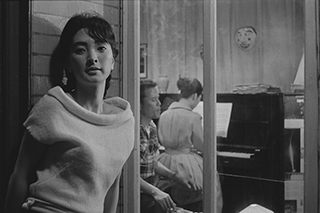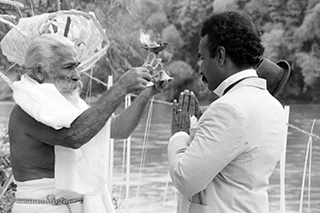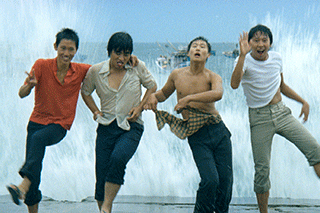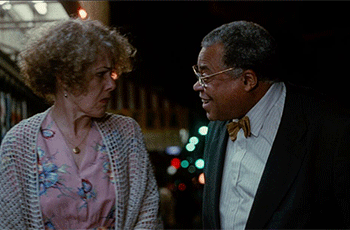Restored in 2023 by The Film Foundation’s World Cinema Project and Cineteca di Bologna in collaboration with the National Film Organization and the family of Tewfik Saleh. Special thanks to Mohamed Challouf and Nadi Nekol Nas. Funding provided by the Hobson/Lucas Family Foundation.

The World Cinema Project (WCP) preserves and restores neglected films from around the world. To date, 64 films from Africa, Asia, Eastern Europe, Central America, South America, and the Middle East have been restored, preserved and exhibited for a global audience. The WCP also supports educational programs, including Restoration Film Schools; intensive, results-oriented workshops allowing students and professionals worldwide to learn the art and science of film restoration and preservation. All WCP titles are available for exhibition rental by clicking "Book This Film."

SÉNÉGAL AN XVI
Director: Babacar Gueye and Orlando Lopez
COUNTRY OF PRODUCTION: Senegal
LANGUAGE: French with English subtitles
COLOR INFO: Black and White
RUNNING TIME: 21 minutes
Restored by The Film Foundation’s World Cinema Project and Cineteca di Bologna at L’Immagine Ritrovata laboratory, in collaboration with the Ministère de la Culture et du Patrimoine Historique de Sénégal – Direction du Cinéma. Restoration funded by the Hobson/Lucas Family Foundation.
This restoration is part of the African Film Heritage Project, an initiative created by The Film Foundation's World Cinema Project, the Pan African Federation of Filmmakers and UNESCO―in collaboration with Cineteca di Bologna―to help locate, restore, and disseminate African cinema.
NOTES ON THE RESTORATION:
The 4K restoration was completed using a 16mm print preserved by the Direction du Cinéma in Senegal. With special thanks to Tiziana Manfredi and Marco Lena.

TOUKI BOUKI
Director: Djibril Diop Mambéty
WRITTEN BY: Djibril Diop Mambéty
EDITING: Siro Asteni
DIRECTOR OF PHOTOGRAPHY: Pap Samba Sow, Georges Bracher
MUSICAL DIRECTOR: Joséphine Baker, Mado Robin, Aminata Fall
SOUND: El Hadji Mbow
FROM: GTC Paris
STARRING: Magaye Niang (Mory), Mareme Niang (Anta), Aminata Fall (Tante Oumy), Ousseynou Diop (Charlie)
COUNTRY OF PRODUCTION: Senegal
LANGUAGE: Wolof with French and English subtitles
COLOR INFO: Color
RUNNING TIME: 88 minutes
PRODUCTION COMPANY: Cinegrit
Restored in 2008 by Cineteca di Bologna/L’Immagine Ritrovata laboratory, in association with The Film Foundation’s World Cinema Project and the family of Djibril Diop Mambéty. Restoration funded by Armani, Cartier, Qatar Airways and Qatar Museum Authority.
Touki Bouki is a prophetic film. Its portrayal of 1973 Senegalese society is not too different from today’s reality. Hundreds of young Africans die every day at the Strait of Gibraltar trying to reach Europe (Melilla and Ceuta). Who has never heard of that before? All their hardships find their voice in Djibril’s film: the young nomads who think they can cross the desert ocean and find their own lucky star and happiness but are disappointed by the human cruelty they encounter. Touki Bouki is a beautiful, upsetting and unexpected film that makes us question ourselves. What a pleasure and what an achievement for Martin Scorsese’s Foundation to give Djibril Diop Mambéty a second life. To all those who support cinema: bravo! –Souleymane Cissé, May 2008
NOTES ON THE RESTORATION:
Touki Bouki has been digitally restored at 2K resolution using the original 35 mm camera and sound negatives provided by the director’s son Teemour Diop Mambéty and preserved at the GTC in Paris. Digital restoration brought the film’s original chromatic elements to light. At the end of the digital process a new 35 mm internegative was produced.
Image: © Courtesy of Teemour Diop Mambéty

VOYAGE AUX ANTILLES DU PRÉSIDENT SENGHOR
Director: Georges Caristan
COUNTRY OF PRODUCTION: Senegal
LANGUAGE: French with English subtitles
COLOR INFO: Black and White
RUNNING TIME: 17 minutes
Restored by The Film Foundation’s World Cinema Project and Cineteca di Bologna at L’Immagine Ritrovata laboratory, in collaboration with the Ministère de la Culture et du Patrimoine Historique de Sénégal – Direction du Cinéma. Restoration funded by the Hobson/Lucas Family Foundation.
This restoration is part of the African Film Heritage Project, an initiative created by The Film Foundation's World Cinema Project, the Pan African Federation of Filmmakers and UNESCO―in collaboration with Cineteca di Bologna―to help locate, restore, and disseminate African cinema.
NOTES ON THE RESTORATION:
The 4K restoration was completed using a 16mm print preserved by the Direction du Cinéma in Senegal. With special thanks to Tiziana Manfredi and Marco Lena.

CAMP DE THIAROYE
Director: Ousmane Sembène and Thierno Faty Sow
WRITTEN BY: Ousmane Sembène and Thierno Faty Sow
EDITING: Kahéna Attia
DIRECTOR OF PHOTOGRAPHY: Smaïl Lakhdar-Hamina
PRODUCER: Mustafa Ben Jemja, Ouzid Dahmane, Mamadou Mbengue
MUSICAL DIRECTOR: Ismaël Lô
STARRING: Sidiki Bakaba, Hamed Camara, Ismaila Cissé, Ababacar Sy Cissé, Moussa Cissoko, Eloi Coly, Ismaël Lô, Pierre Londiche
COUNTRY OF PRODUCTION: Senegal, Algeria, Tunisia
LANGUAGE: German, French, Wolof, English
COLOR INFO: Color
RUNNING TIME: 153 minutes
PRODUCER: Mustafa Ben Jemja, Ouzid Dahmane, Mamadou Mbengue
Restored by The Film Foundation’s World Cinema Project and Cineteca di Bologna at L’Immagine Ritrovata laboratory in association with the Tunisian Ministry of Cultural Affairs and the Senegalese Ministry of Culture and Historical Heritage. With special thanks to Mohamed Challouf and Association Ciné-Sud Patrimoine. Restoration funded by the Hobson/Lucas Family Foundation.
This restoration is part of the African Film Heritage Project, an initiative created by The Film Foundation’s World Cinema Project, the Pan African Federation of Filmmakers and UNESCO – in collaboration with Cineteca di Bologna – to help locate, restore, and disseminate African cinema.
NOTES ON THE RESTORATION:
CAMP DE THAIROYE was restored in 4K at L'Immagine Ritrovata using a second-generation internegative and the original sound negative, preserved at the Tunisian Ministry of Cultural Affairs.

HOUSEMAID, THE
HANYO
Director: Kim Ki-Young
WRITTEN BY: Kim Ki-Young
EDITING: Kim Ki-Young
DIRECTOR OF PHOTOGRAPHY: Kim Deok-jin
PRODUCER: Kim Young-chul
MUSICAL DIRECTOR: Han Sang-Ki
ART DIRECTOR: Park Seok-in
STARRING: Lee Eunshim (Housemaid), Kim Jin-kyu (Dong-sik), Ju Jeung-nyeo (Dong-sik’s wife), Um Aeng-ran (Cho Kyung-hee)
COUNTRY OF PRODUCTION: South Korea
LANGUAGE: Korean with English subtitles
COLOR INFO: Black and White
RUNNING TIME: 110 minutes
PRODUCTION COMPANY: Korean Munye Films Co., Ltd.
PRODUCER: Kim Young-chul
Restored in 2008 by the Korean Film Archive (KOFA), in association with The Film Foundation's World Cinema Project and HFR-Digital Film laboratory. Additional restoration funded by Armani, Cartier, Qatar Airways and Qatar Museum Authority.
Kim Ki-young’s Hanyo, or The Housemaid, is one of the true classics of South Korean cinema, and when I finally had the opportunity to see the picture, I was startled. That this intensely, even passionately claustrophobic film is known only to the most devoted film lovers in the west is one of the great accidents of film history. I’m proud that the World Cinema Foundation is participating in the restoration and preservation of this remarkable picture. I am eager for more people to get to know and love The Housemaid.
–Martin Scorsese, February 2008
NOTES ON THE RESTORATION:
Hanyo has been restored digitally by the Korean Film Archive (KOFA) with the support of the World Cinema Foundation. The original negative of the film was found in 1982 with two missing reels, 5 and 8. In 1990 an original release print with hand-written English subtitles was found and used to complete the copy. This surviving print was highly damaged, and the English subtitles occupied almost half of the frame area. The long and complex restoration process has involved the use of a special subtitle-removal software and included flicker and grain reduction, scratch and dust removal, color grading.
Image: © Courtesy of Korean Film Archive

TREASURE, THE
NIDHANAYA
Director: Lester James Peries
WRITTEN BY: Tissa Abeysekera
EDITING: Lester James Peries, Edwin Leetin, Gladwyn Fernando
DIRECTOR OF PHOTOGRAPHY: M.S. Anandan
ADAPTED BY: G. B. Senanayake
MUSICAL DIRECTOR: Premasiri Khemadasa
ART DIRECTOR: J.A. Vincent Perera
STARRING: Gamini Fonseka, Malani Fonseka, Saman Bokalawala, Francis Perera, Mapa Gunaratne, Shanthi Lekha, Trilicia Gunawardene, Thilakasiri Fernando, J.B.L. Fernando, Thalatha Gunasekera, Kumarasinghe Appuhamy, K.L. Coranelis Appuhamy, Barry Whittington, Wijeratne Warakagoda
COUNTRY OF PRODUCTION: Sri Lanka
LANGUAGE: Sinhala
COLOR INFO: Black and White
RUNNING TIME: 108 minutes
PRODUCTION COMPANY: P.E.E. Anthonypillai for Ceylon Studios
Restored in 2013 by Cineteca di Bologna/L'Immagine Ritrovata laboratory, in association with The Film Foundation’s World Cinema Project, Lester James and Sumitra Peries, the National Film Archive of India, the National Film Corporation of Sri Lanka, Cinemas Ltd. Additional restoration elements provided by Degeto Films. Restoration funded by Doha Film Institute.
Nidhanaya is based on a dark tale by G.B. Senanayake and is considered a milestone film that people, even abroad, admire the most, albeit it is atypical of Lester James Peries’ customary family dramas. The story revolves around a psychotic killer yet is an underlying serious political study on the degradation of a class of society. In 1972 this film won the Silver Lion of St Mark at the 33th Venice International Film Festival and was selected as one of the outstanding films of the year, receiving a Diploma at the London Film Festival. It was also voted as the best film of the first 50 years of Sri Lankan cinema.
My most controversial film is Nidhanaya, which received a very positive reception at the Venice Film Festival. The most accurate critics highlighted that, despite its setting in 1911, this film holds a strong social and political value in denouncing the system. The character is trapped between two cultures: the Western/British one and his culture of origin—he is lost between two worlds. Unable to adapt to either one or the other, he absorbs the worse elements of the two cultures; the society changes and he goes insane.
- Lester James Peries
NOTES ON THE RESTORATION:
The restoration of Nidhanaya was made possible through the use of two key elements: a 35mm positive print struck from the original camera negative and held by Degeto Film, and a combined dupe negative preserved at the National Film Archive of India.
The prints were scanned at 4K resolution. After scanning, the image was stabilized and cleaned, and all wear marks were eliminated. Image grading recovered the richness of the original cinematography. The soundtrack was also digitally cleaned and background noise reduction was applied to reduce imperfections without losing the dynamic features of the original. The digital restoration produced a new 35mm internegative.
The World Cinema Foundation would like to thank the following individuals and organizations for their support: G R Padmaraj and Cinemas Ltd, National Film Corporation of Sri Lanka, National Film Archive of India, Shivendra Singh Dungarpur, Ravindra and Sam Randeniya, and Hubert Niogret.
Special thanks to Lester James Peries and Sumitra Peries for facilitating the restoration process.
Image: © Courtesy of National Film Corporation of Sri Lanka

STARS IN BROAD DAYLIGHT
NUJUM AL-NAHAR
Director: Ossama Mohammed
WRITTEN BY: Ossama Mohammed
EDITING: Antoinette Azarieh
DIRECTOR OF PHOTOGRAPHY: Abdulqader Sharbaji
STARRING: Abdellatif Abdul Hamid, Zuhair Abdulkarim, Sabah As-Salem, Saad Eddin Baqdoones, Fuad Ghazi, Muhsen Ghazi, Radwan Jamoos, Zuhair Ramadan, Maha Saleh
COUNTRY OF PRODUCTION: Syria
LANGUAGE: Arabic with English subtitles
COLOR INFO: Color
RUNNING TIME: 105 minutes
PRODUCTION COMPANY: National Film Organization
Restored by The Film Foundation’s World Cinema Project and Cineteca di Bologna at L’Immagine Ritrovata laboratory, in collaboration with Ossama Mohammed. Funding provided by the Hobson/Lucas Family Foundation.
NOTES ON THE RESTORATION:
The restoration used the best surviving element outside Syria, a 35mm positive print acquired by a German television network in the 1990s. Ossama Mohammed approved the grading. Restoration work was completed in 2024 by L’Immagine Ritrovata.

DUPES, THE
AL-MAKHDU’UN
Director: Tewfik Saleh
WRITTEN BY: Tewfik Saleh
EDITING: Farin Dib, Saheb Haddad
DIRECTOR OF PHOTOGRAPHY: Bahgat Heidar
STARRING: Mohamed Kheir-Halouani, Abderrahman Alrahy, Bassan Lofti Abou-Ghazala, Saleh Kholoki, Thanaa Debsi
COUNTRY OF PRODUCTION: Syria
LANGUAGE: Arabic with English subtitles
RUNNING TIME: 107 minutes
NOTES ON THE RESTORATION:
The 4K restoration used a 35mm dupe negative preserved by the Bulgarian National Film Archive (Bulgarska Nacionalna Filmoteka) and was completed in 2023 by L’Immagine Ritrovata laboratory.

BRIGHTER SUMMER DAY, A
GU LING JIE SHAO NIAN SHA REN SHI JIAN
Director: Edward Yang
WRITTEN BY: Edward Yang, Yan Hangya, Yang Shunqing, Lai Mingtang
EDITING: Chen Bowen
DIRECTOR OF PHOTOGRAPHY: Zhang Huigong, Li Longyu
FROM: Central Motion Picture Corporation, Taipei
STARRING: Zhang Zhen (Xiao Si’r), Lisa Yang (Ming), Zhang Guozhu (Zhang Ju), Elaine Jin (Mrs Zhang), Wang Juan (Elder Sister), Ke Yulun (Airplane), Tan Zhigang (Ma)
COUNTRY OF PRODUCTION: Taiwan
LANGUAGE: Mandarin and Taiwanese with French and English subtitles
COLOR INFO: Color
RUNNING TIME: 237 minutes
PRODUCTION COMPANY: Yang and His Gang Filmmakers
SET DESIGNER: Yu Weiyan, Edward Yang
Restored in 2009 by Cineteca di Bologna/L’Immagine Ritrovata laboratory, in association with The Film Foundation’s World Cinema Project, the Central Motion Picture Corporation, and the Edward Yang Estate. Scan performed at Digimax laboratories in Taipei. Restoration funded by Armani, Cartier, Qatar Airways and Qatar Museum Authority.
It is easy to restore a film’s image, but much harder to revive that feeling of seeing a classic for the first time. Fifteen years ago, Edward Yang’s A Brighter Summer Day was released, heralding a new talent in world cinema. Each year since has further confirmed its status as a classic, but at the cost of increased wear and tear on the prints. Restoration is usually reserved for relics from decades ago. But sometimes we need to dust off recent memories to remind us how brightly the not too distant past shined. Thanks to the latest digital technology, we can seize these celluloid moments even as they begin to slip irrevocably from our grasp. In June of 2007 when he was only 59 years old, we lost Edward Yang forever. I’m very happy that A Brighter Summer Day has been restored so a new generation of filmgoers can feel the excitement of seeing it for the first time. –Wong Kar-Wai, May 2009
NOTES ON THE RESTORATION:
The restoration of the uncut version of A Brighter Summer Day used the original 35mm camera and sound negatives provided by the Edward Yang Estate and preserved at the Central Motion Pictures Corporation in Taipei. Due to the deterioration of the original camera negative an intermediate of the film printed at the time was also used. The digital restoration produced a new 35mm internegative.
Image: © Courtesy of Edward Yang Estate/CMPC

TAIPEI STORY
QING MEI ZHU MA
Director: Edward Yang
WRITTEN BY: Edward Yang, Hou Hsiao-hsien, Chu T’ien-wen
DIRECTOR OF PHOTOGRAPHY: Yang Wei-han
PRODUCER: Hou Hsiao- hsien, Lin Rong-feng
STARRING: Hou Hsiao-hsien (Lung), Tsai Chin (Chin), Lai Teh-nan (Chin's father), Chen Su-fang (Mrs. Mei), Wu Nien-Jen (Taxi driver), Ko I-Chen (Architect), Ko Su-wun (Gwan)
COUNTRY OF PRODUCTION: Taiwan
LANGUAGE: Madarin with English subtitles
COLOR INFO: Color
RUNNING TIME: 119 minutes
PRODUCER: Hou Hsiao- hsien, Lin Rong-feng
Restored by The Film Foundation’s World Cinema Project at Cineteca di Bologna/L’immagine Ritrovata laboratory in association with the Cinémathèque Royale de Belgique and Hou Hsiao-hsien.

BOYS FROM FENGKUEI, THE
FENG GUI LAI DE REN
Director: Hou Hsiao-hsien
WRITTEN BY: T'ien-wen Chu
DIRECTOR OF PHOTOGRAPHY: Kun Hao Chen
SOUND: Duu-Chih Tu
STARRING: Chun-fang Chang, Shih Chang, Doze Niu, Chao P'eng-chue, Chung-Hua Tou, Li-Yin Yang
COUNTRY OF PRODUCTION: Taiwan
LANGUAGE: Mandarin with English subtitles
COLOR INFO: Color
RUNNING TIME: 101 minutes
Restored by the Cinémathèque Royale de Belgique in collaboration with Hou Hsiao-hsien and The Film Foundation’s World Cinema Project.

Mysterious Object at Noon
DOKFAH NAI MEU MAAN
Director: Apichatpong Weerasethakul
EDITING: Mingmongkol Sonakul, Apichatpong Weerasethakul
DIRECTOR OF PHOTOGRAPHY: Apichatpong Weerasethakul, Prasong Klimborron
PRODUCER: Gridthiya Gaweewong, Mingmongkol Sonakul
SOUND: Teekadetch Watcharatanin, Sirote Tulsook, Paisit Phanpruksachat, Adhinan Adulayasis
STARRING: Somsri Pinyopol, Duangjai Hiransri, To Hanudomlapr, Kannikar Narong, and the villagers of Thailand
COUNTRY OF PRODUCTION: Thailand
LANGUAGE: Thai
COLOR INFO: Black and White
RUNNING TIME: 88 minutes
PRODUCTION COMPANY: 9/6 Cinema Factory, Firecracker Films, Bangkok
PRODUCER: Gridthiya Gaweewong, Mingmongkol Sonakul
Restored in 2013 by the Austrian Film Museum and Cineteca di Bologna/L’Immagine Ritrovata laboratory, in association with The Film Foundation’s World Cinema Project, LISTO laboratory in Vienna, Technicolor Ltd in Bangkok, and Apichatpong Weerasethakul. Restoration funded by Doha Film Institute.
On his journey, the director hears a story which he then asks people to continue as they wish— like a game of Chinese Whispers (and relating also to the French Surrealists’ concept of the “cadavre exquis”). The original title, Dokfah nai meu maan, roughly translates as Heavenly Flower in Devil’s Hand. The name of that flower, Dokfah, is also the name of the woman who appears in the story-within-a-film as the teacher of a young paraplegic boy. The title is reminiscent of an archetypical Thai melodrama, but in the hands of the most imaginative re interpreter of national tradition, it becomes an epic meta-narrative.
I want to give the audience the freedom to fly or to float, to just let their mind go here and there, to drift, like when we sit in a train, listen to a Walkman, and look at the landscape. It is liberating, and also the audience understands that they are not watching a routine, three act narrative.
- Apichatpong Weerasethakul
NOTES ON THE RESTORATION:
The restoration of Mysterious Object at Noon utilized the 35mm duplicate negative with burned-in English subtitles deposited at the Austrian Film Museum by Apichatpong Weerasethakul in 2007. This negative was struck in 1999 from the (now lost) original 16mm camera reversal element.
The duplicate negative was scanned at 3K at the Austrian Film Museum. Painstaking digital restoration work was undertaken to remove dust, scratches and other visible marks while keeping the look (and the specific defects) of the original 16mm camera reversal material intact. Color correction was carried out at the LISTO laboratory in Vienna; the 35mm optical soundtrack negative was transferred at L’Immagine Ritrovata in Bologna; the digital sound restoration was performed at Technicolor Ltd in Bangkok.
The restoration was carried out in close collaboration with the filmmaker and completed in June 2013. The process produced a new 35mm internegative.
Image: © Courtesy of Apichatpong Weerasethakul
